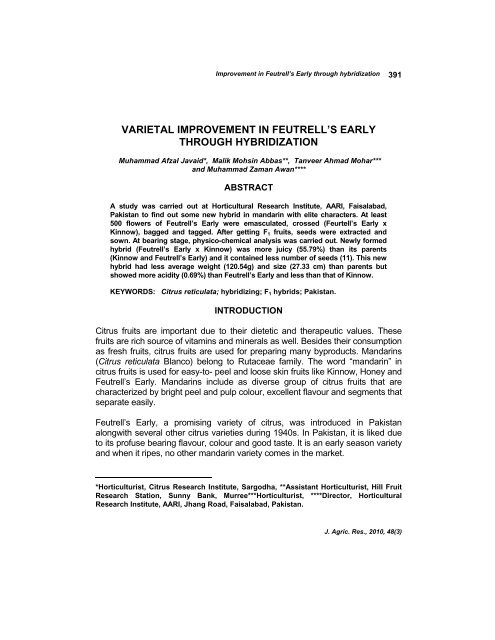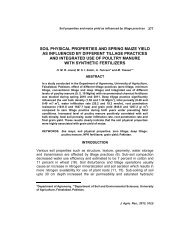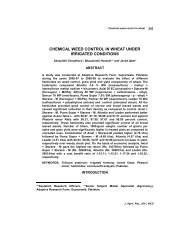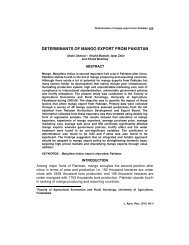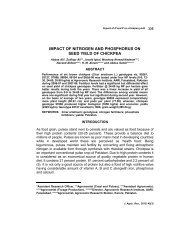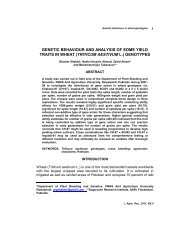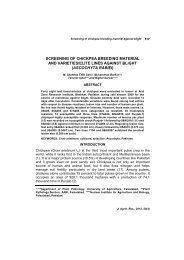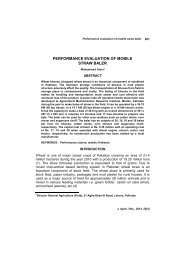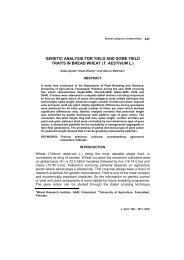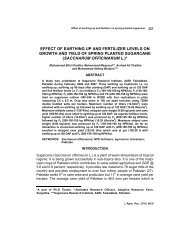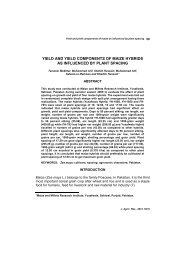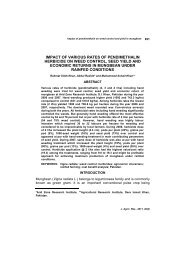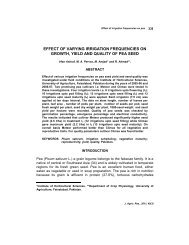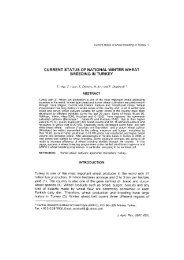varietal improvement in feutrell's early through hybridization
varietal improvement in feutrell's early through hybridization
varietal improvement in feutrell's early through hybridization
You also want an ePaper? Increase the reach of your titles
YUMPU automatically turns print PDFs into web optimized ePapers that Google loves.
Improvement <strong>in</strong> Feutrell’s Early <strong>through</strong> <strong>hybridization</strong><br />
391<br />
VARIETAL IMPROVEMENT IN FEUTRELL’S EARLY<br />
THROUGH HYBRIDIZATION<br />
Muhammad Afzal Javaid*, Malik Mohs<strong>in</strong> Abbas**, Tanveer Ahmad Mohar***<br />
and Muhammad Zaman Awan****<br />
ABSTRACT<br />
A study was carried out at Horticultural Research Institute, AARI, Faisalabad,<br />
Pakistan to f<strong>in</strong>d out some new hybrid <strong>in</strong> mandar<strong>in</strong> with elite characters. At least<br />
500 flowers of Feutrell’s Early were emasculated, crossed (Feurtell’s Early x<br />
K<strong>in</strong>now), bagged and tagged. After gett<strong>in</strong>g F 1 fruits, seeds were extracted and<br />
sown. At bear<strong>in</strong>g stage, physico-chemical analysis was carried out. Newly formed<br />
hybrid (Feutrell’s Early x K<strong>in</strong>now) was more juicy (55.79%) than its parents<br />
(K<strong>in</strong>now and Feutrell’s Early) and it conta<strong>in</strong>ed less number of seeds (11). This new<br />
hybrid had less average weight (120.54g) and size (27.33 cm) than parents but<br />
showed more acidity (0.69%) than Feutrell’s Early and less than that of K<strong>in</strong>now.<br />
KEYWORDS: Citrus reticulata; hybridiz<strong>in</strong>g; F 1 hybrids; Pakistan.<br />
INTRODUCTION<br />
Citrus fruits are important due to their dietetic and therapeutic values. These<br />
fruits are rich source of vitam<strong>in</strong>s and m<strong>in</strong>erals as well. Besides their consumption<br />
as fresh fruits, citrus fruits are used for prepar<strong>in</strong>g many byproducts. Mandar<strong>in</strong>s<br />
(Citrus reticulata Blanco) belong to Rutaceae family. The word “mandar<strong>in</strong>” <strong>in</strong><br />
citrus fruits is used for easy-to- peel and loose sk<strong>in</strong> fruits like K<strong>in</strong>now, Honey and<br />
Feutrell’s Early. Mandar<strong>in</strong>s <strong>in</strong>clude as diverse group of citrus fruits that are<br />
characterized by bright peel and pulp colour, excellent flavour and segments that<br />
separate easily.<br />
Feutrell’s Early, a promis<strong>in</strong>g variety of citrus, was <strong>in</strong>troduced <strong>in</strong> Pakistan<br />
alongwith several other citrus varieties dur<strong>in</strong>g 1940s. In Pakistan, it is liked due<br />
to its profuse bear<strong>in</strong>g flavour, colour and good taste. It is an <strong>early</strong> season variety<br />
and when it ripes, no other mandar<strong>in</strong> variety comes <strong>in</strong> the market.<br />
*Horticulturist, Citrus Research Institute, Sargodha, **Assistant Horticulturist, Hill Fruit<br />
Research Station, Sunny Bank, Murree***Horticulturist, ****Director, Horticultural<br />
Research Institute, AARI, Jhang Road, Faisalabad, Pakistan.<br />
J. Agric. Res., 2010, 48(3)
392<br />
M. A. Javaid et al.<br />
Along the merits, Feutrell’s Early has also some limitations like small fruits with<br />
poor juice quality, accepted for lack of alternatives and slight problem of<br />
rac<strong>in</strong>ess. Due to a very soft r<strong>in</strong>d (sk<strong>in</strong>), fruits are damaged dur<strong>in</strong>g harvest<strong>in</strong>g and<br />
shipp<strong>in</strong>g which results <strong>in</strong> heavy post-harvest losses. It has a short crush<strong>in</strong>g<br />
season for juice makers (5). A long term breed<strong>in</strong>g programme was <strong>in</strong>itiated to<br />
improve Feutrell’s Early by genetic means preserv<strong>in</strong>g its promis<strong>in</strong>g characters.<br />
There are different means to resolve issue like conventional <strong>hybridization</strong>, which<br />
<strong>in</strong>clude use of monoembryonic parents, use of dom<strong>in</strong>ant markers (trifoliate leaf)<br />
<strong>in</strong> pollen parent, <strong>in</strong>terploid <strong>hybridization</strong>, mutation breed<strong>in</strong>g and selection of<br />
natural mutants, chimeras and bud stra<strong>in</strong>/sports (variants among a clonal<br />
population). Out of these techniques the conventional <strong>hybridization</strong> method was<br />
used. Numerous species of genera <strong>in</strong> the subfamily Aurantioideae of family<br />
Rutaceae are both cross and graft compatible to many commercially important<br />
citrus cultivars. Hybridizaiton is the sexual mat<strong>in</strong>g of plants conta<strong>in</strong><strong>in</strong>g desirable<br />
character. The objective is to comb<strong>in</strong>e <strong>in</strong> a s<strong>in</strong>gle variety the useful<br />
characteristics of two or more l<strong>in</strong>es, varieties or species. The first and most<br />
important step <strong>in</strong> <strong>hybridization</strong> is the wise selection of parents for a cross, which<br />
is made on the basis of traits to be comb<strong>in</strong>ed and their model of <strong>in</strong>heritance. A<br />
lot of <strong>improvement</strong> <strong>in</strong> fruit varieties has been brought out by <strong>in</strong>tercross<strong>in</strong>g of<br />
various varieties and species. Although <strong>in</strong> fruits, it is a long term and lengthy<br />
process, yet several excellent varieties have been produced as a result of<br />
<strong>hybridization</strong>.<br />
Breeders have produced large number of hybrids <strong>in</strong> Florida, from many<br />
comb<strong>in</strong>ations of varieties and species (9, 10). Several citranges were produced,<br />
which were backcrossed with sweet orange, giv<strong>in</strong>g citrangors. However, none<br />
was obta<strong>in</strong>ed, which could comb<strong>in</strong>e a high degree of hard<strong>in</strong>ess with good<br />
orange fruit quality. The most promis<strong>in</strong>g citranges appeared to be a partial<br />
substitute for the lemon (9).<br />
Ibrahim (4) reported that 175 hybrids of orange and oraneloes were made and<br />
eight were selected. These hybrids produced good quality fruit with abundance<br />
of juice (50%) and TSS/acidity ratios and p<strong>in</strong>eapple were palatable and<br />
acceptable. Hussa<strong>in</strong> et al. (3) reported that a cross of p<strong>in</strong>e apple x Musambi<br />
produced fruits hav<strong>in</strong>g excellent quality, high juice percentage (42.27), TSS<br />
(9.71%), acidity (0.66%) and yield (400 fruits/plant) and matured <strong>in</strong> <strong>early</strong><br />
December.<br />
By cross<strong>in</strong>g K<strong>in</strong>g Mandar<strong>in</strong> with Willow Leaf, K<strong>in</strong>now was released as hybrid <strong>in</strong><br />
1915. After partition of the sub-cont<strong>in</strong>ent, K<strong>in</strong>now replaced the old variety Santra.<br />
J. Agric. Res., 2010, 48(3)
Improvement <strong>in</strong> Feutrell’s Early <strong>through</strong> <strong>hybridization</strong><br />
393<br />
Three hybrids viz. Fair Child, Fremont and Fortune were developed with brick<br />
colour giv<strong>in</strong>g outstand<strong>in</strong>g performance (2).<br />
The present study was aimed to evolve new hybrid hav<strong>in</strong>g more yield and<br />
better quality with good commercial value. Feutrell’s Early and K<strong>in</strong>now<br />
cultivars of mandar<strong>in</strong> were selected to obta<strong>in</strong> a hybrid with desired<br />
characters.<br />
MATERIALS AND METHODS<br />
This breed<strong>in</strong>g work was started at Horticultural Research Institute, AARI,<br />
Faisalabad, Pakistan dur<strong>in</strong>g the month of February, 1991 to have a new<br />
hybrid <strong>in</strong> mandar<strong>in</strong> with elite characters. For this purpose seven years old<br />
matured plants of Feutrell’s Early and K<strong>in</strong>now were selected as parents. The<br />
project was undertaken to add some elite characters <strong>in</strong> Feutrell’s Early by<br />
us<strong>in</strong>g conventional breed<strong>in</strong>g approach. Feutrell’s Early was kept as female<br />
parent and K<strong>in</strong>now as male parent. These plants were checked for <strong>in</strong>sect,<br />
pest and disease. Dur<strong>in</strong>g the flower<strong>in</strong>g season, about 500 flowers of<br />
Feutrell’s Early were emasculated and crossed with the flowers of K<strong>in</strong>now.<br />
After cross<strong>in</strong>g, flowers were wrapped <strong>in</strong> butter paper till the fruit set to avoid<br />
foreign <strong>in</strong>terruption and 80 hybrid fruits of Feutrell’s Early x K<strong>in</strong>now were<br />
obta<strong>in</strong>ed dur<strong>in</strong>g August, 1991. After gett<strong>in</strong>g F 1 fruits, seeds were extracted<br />
and sown <strong>in</strong> earthen pots. As a result three seedl<strong>in</strong>gs of Feutrell’s Early x<br />
K<strong>in</strong>now were obta<strong>in</strong>ed and transplanted <strong>in</strong> the nursery dur<strong>in</strong>g 1995. These<br />
plants were transplanted <strong>in</strong> the fields <strong>in</strong> RCBD and after their juvenile stage<br />
the plants started to bear. Ten fruits of each hybrid plant were taken at<br />
random from all four sides of the trees and were analyzed dur<strong>in</strong>g 2007 to<br />
2008. The means of the both years were <strong>in</strong>terpreted.<br />
Data were analyzed statistically us<strong>in</strong>g Fishers analysis of variance and<br />
treatments were compared us<strong>in</strong>g the least significant difference (LSD) test at<br />
5 percent probability level (7). There were three treatments, which were<br />
repeated five times mak<strong>in</strong>g a total of 15 experimental units.<br />
RESULTS AND DISCUSSION<br />
The data on average weight and size of fruit <strong>in</strong>dicated that fruit weight (120.54 g)<br />
and size (27.33 cm 2 ) of newly developed hybrid, Feutrell’s Early x K<strong>in</strong>now,<br />
rema<strong>in</strong>ed less than both of parents i.e. K<strong>in</strong>now and Feutrell’s Early (Table 1).<br />
The newly developed hybrid also showed less peel thickness (0.342 cm) than<br />
K<strong>in</strong>now and Feutrell’s Early (parents). The peel thickness of K<strong>in</strong>now and<br />
J. Agric. Res., 2010, 48(3)
394<br />
M. A. Javaid et al.<br />
Feutrell’s Early was 0.378 cm and 0.358 cm, respectively. The surface of peel of<br />
new hybrid was more smooth and attractive <strong>in</strong> colour than parents.<br />
Table.<br />
Physio chemical analysis of Feutrell’s Early x K<strong>in</strong>now compared with parents.<br />
Treatments<br />
Average<br />
weight<br />
of fruit<br />
(g)<br />
Average<br />
size of<br />
fruit<br />
(cm)<br />
Peel<br />
thickness<br />
(cm)<br />
Peel<br />
%age<br />
K<strong>in</strong>now 200.00a 48.14a 0.378a 26.00a<br />
b<br />
Juice<br />
%age<br />
TSS<br />
%age<br />
Acidity<br />
%age<br />
TSS/<br />
acidity<br />
ratio<br />
Averag<br />
e<br />
No. of<br />
seeds/<br />
fruit<br />
47.65b 12a 0.75a 21.11a 24a<br />
Feutrell’s. Early 138.59b 32.1b 0.358b 28.15a 45.67c 9.5b 0.44c 16.52b 16b<br />
Feutrell’s Early x 120.54c 27.33c 0.342b 25.56b 55.79a 12.5a 0.69b 17.39b 11c<br />
K<strong>in</strong>now<br />
LSD (0.05) 5.409 2.44 0.0184 2.192 1.777 0.921 0.055 1.231 2.381<br />
The physico-chemical analysis showed that Feutrell’s Early x K<strong>in</strong>now had 25.56<br />
percent peel which was also less than either of its parents. Juice percentage<br />
Feutrell’s Early x K<strong>in</strong>now was higher (55.79%) than parents (K<strong>in</strong>now 47.65%<br />
and Feutrell’s Early 45.67%) (Table).<br />
The newly developed hybrid showed more TSS (12.5%), than both the parents.<br />
The data regard<strong>in</strong>g acidity showed that Feutrell’s Early, one of the parents, was<br />
less acidic than hybrid (0.69%) which was less than that of K<strong>in</strong>now (0.75%).<br />
TSS/acidity ratio of hybrid (17.39) was also less than K<strong>in</strong>now (21.11).<br />
J. Agric. Res., 2010, 48(3)
Improvement <strong>in</strong> Feutrell’s Early <strong>through</strong> <strong>hybridization</strong><br />
395<br />
Number of seeds <strong>in</strong> both K<strong>in</strong>now and Feutrell’s Early is limit<strong>in</strong>g factor from<br />
export po<strong>in</strong>t of view. The consumers and exporters demand the fruit with less<br />
number of seeds, less acidity with more yield potentials. The promis<strong>in</strong>g factor of<br />
newly developed hybrid was that it conta<strong>in</strong>ed less number of seeds (11) as<br />
compared to Feutrell’s Early (16) and K<strong>in</strong>now (24).<br />
REFERENCES<br />
1. Frost, H. B. 1915. Crossed K<strong>in</strong>g Mandar<strong>in</strong> with Willow Leaf. The Citrus<br />
Industry. Vol.1:16.<br />
2. Fure, J. R. 1964. New tanger<strong>in</strong>e for the desert. Citrog. 49:266-76.<br />
3. Hussa<strong>in</strong>, M. I. Haq, M. A. Javaid. 1992. Performance of new sweet<br />
orange hybrid p<strong>in</strong>e apple x musambi. Punjab Fruit Journal. Jan-Dec.<br />
45(1-4):1-6.<br />
4. Ibrahim, M. 1983. Evolution of new citrus variety <strong>through</strong> <strong>hybridization</strong><br />
Pak. Proc. National Hort. Semi. NARC-Hort. Found-Pakistan,<br />
Islamabad. June 28-30. p. 22-29.<br />
5. Khan, I. A. 1992a. The K<strong>in</strong>now Culture. Proc. Fruit Int. Sem<strong>in</strong>ar on<br />
Citriculture <strong>in</strong> Pakistan. Univ. Agric. Faisalabad. December 2-5, 1992. p.<br />
512-513.<br />
6. Khan, I. A. 1992b. Germplasm resources and citrus breed<strong>in</strong>g. Proc.<br />
First Int. Sem<strong>in</strong>ar on Citriculture. Univ. Agric. Faisalabad. p. 85-86.<br />
7. Steel, R.G.D. and J.H.Torrie. 1984. Pr<strong>in</strong>ciples and Procedures of<br />
Statistical Analysis. McGraw Hill Book Co., New York, USA.<br />
8. Sw<strong>in</strong>gle, W.T. and T.R. Rob<strong>in</strong>son. 1927. Citranges and some related<br />
hybrid fruits. U. S. Dept. Agr. Yearbook. 1926:223-25.<br />
9. Sw<strong>in</strong>gle, W.T., T.R. Rob<strong>in</strong>son and E. M. Savage. 1931. New citrus<br />
hybrids, U. S. Dept. Agri. Circ. 181:20.<br />
10. Traub, H. P and T. R. Rob<strong>in</strong>son. 1937. Improvement of subtropical fruit<br />
crops: citrus. U. S. Dept. Agr. Yearbook. 1937:749-826.<br />
J. Agric. Res., 2010, 48(3)


